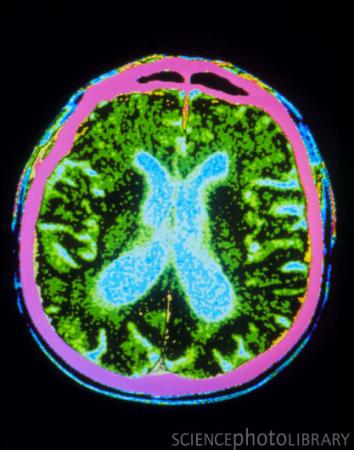
帕金森综合症病人脑部CT扫描彩图(图)
在患有帕金森综合症病人的大脑植入刺激用的移植物后,在随访的10年间里,他们在行动能力上能持续恢复,但移植后其它部分功能上的恢复会随着时间延长而逐渐消失。该研究的论文发表在最近的JAMA杂志的子刊《Archives of Neurology》上。
之前已经有一些临床试验证实:对帕金森综合症病人的下丘脑核心进行深度刺激(STN-DBS)安全无害,并且也已证实了这种刺激部分脑区域的方法相比其它药物治疗方法在恢复病人行动能力上更为有效,能明显提高生活质量。这种STN刺激手术对病人行动能力改善被报道可以持续长达5到8年之久,而其它术后恢复的功能随着时间逐渐衰减,这主要是由于轴位信号的恶化,该论文的作者,意大利佩鲁贾大学的Anna Castrioto说道:“但我们还缺乏预后随访时间在8年以上的临床试验。”
Castrioto的研究小组开展了一项试验,她们在1996到2000年间共纳入了18例患有严重帕金森综合症并接受了DBS治疗的病人。通过在移植前、移植后1年、5年、10年这四个时间点对病人进行了各种相关测试,所有的记录都以录像形式保存。在测试时,所有的病人都不接受任何药物和其它的刺激。在每项测试中,研究者们还记录了平时每位病人所使用的治疗药物和剂量。
在移植术后的10年里,在STN-DBS治疗和药物治疗的联合作用下,病人的行动能力、睡眠和动作性震颤、运动迟缓和僵化程度均得到明显的改善。尽管如此,成轴信号的改善(例如摆姿势、步法和平衡)衰减得最为严重。
Castrioto说道:“我们的实验进一步证实了STN刺激疗法对治疗帕金森综合症有效,且疗效可长达10年以上。” (生物探索 Jun译)
生物探索推荐英文论文原文摘要:
Ten-Year Outcome of Subthalamic Stimulation in Parkinson Disease
Objective To assess the 10-year motor outcome of deep brain stimulation of the subthalamic nucleus (STN-DBS) in patients with Parkinson disease (PD).
Design Patients with PD with bilateral STN-DBS were assessed according to the Core Assessment Program for Surgical Interventional Therapies in Parkinson's Disease protocol and videotaped at baseline and 1, 5, and 10 years after surgery. An independent rater blinded to stimulation and medication condition scored the 10-year video assessments.
Setting Movement Disorders Centre, Toronto Western Hospital, University Health Network, University of Toronto.
Patients Eighteen patients with advanced PD and 10-year follow-up of STN-DBS.
Intervention Bilateral STN-DBS surgery.
Main Outcome Measures The primary outcome was the change in blinded Unified Parkinson's Disease Rating Scale (UPDRS) motor scores/subscores between the no medication/stimulation condition vs the no medication/no stimulation condition at 10 years. Secondary outcomes were the changes in blinded UPDRS motor scores between the medication/no stimulation and medication/stimulation conditions, UPDRS II scores, UPDRS IV dyskinesia and motor fluctuations scores, and anti-PD medication dose (levodopa equivalent daily dose) at different points.
Results In the 18 patients available for follow-up at 10 years, STN-DBS still significantly improved the UPDRS total motor score (P = .007) and resting and action tremor (P < .01 and P = .02, respectively) and bradykinesia (P = .01) subscores. The UPDRS II scores in the medication and no medication conditions, UPDRS IV dyskinesia and motor fluctuations scores, and the levodopa equivalent daily dose were also significantly reduced compared with baseline. Axial signs showed the most progressive decline in stimulation and levodopa response over the years.
Conclusion This class III study provides evidence that stimulation-induced motor improvement was sustained overall at 10 years, although part of the initial benefit wore off mainly because of progressive loss of benefit on axial signs over time.







